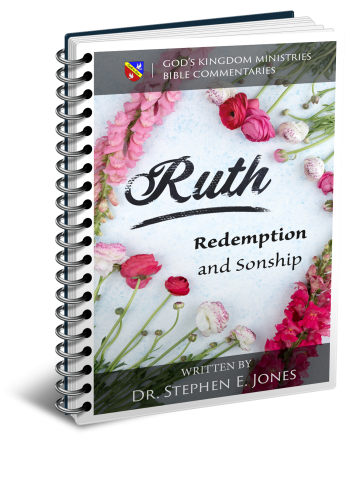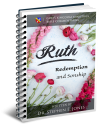Latest Posts
View the latest posts in an easy-to-read list format, with filtering options.

The book of Ruth is the Bible's primary illustration of the law of sonship found in Deuteronomy 25. The story also illustrates the principles of New Covenant marriage as God set forth from the beginning. In addition, it is a natural sequel to the last five chapters of the book of Judges, showing the moral contrast between the home towns of Saul and David as a way of explaining the failure of Saul and the success of David.
Category - Bible Commentaries

The story of Ruth took place in the time of the Judges, as the first verse tells us, and so it is placed in the canon immediately after the Book of Judges. It is one of the most beloved of the Old Testament books, because it is a story of romance and marriage. Many also like the book because it is not strict teaching (as is Leviticus and Deuteronomy). It is, in fact, a pleasant way of teaching a portion of the law through storytelling.
I followed a similar path by writing The Anava Chronicles in which I go back in time to walk with the biblical characters and to instruct them in New Covenant principles that they would have known, had it not been for the Old Covenant veil over their eyes. To read a commentary on the veil requires much more discipline than reading a story illustrating it.
In doing this, I used Shakespeare’s principle of “teaching through entertainment.” The main difference is that Shakespeare taught a loose version of secular history, while I revealed biblical history with some imagination (and revelation) to fill in the biblical gaps.
To be sure, Ruth is most beloved on account of its theme of love and marriage. However, from the standpoint of biblical teaching, it is mostly a revelation of the law in Deut. 25:5-10. This puts the focus more on sonship than on marriage itself. The marriage itself provides us with the backdrop to sonship, since marriage is a requirement for legitimate sonship.
Further, the backdrop for the main love story is the famine which drove Elimelech and Naomi to the land of Moab, recreating the story of Israel’s sojourn in Egypt, which too was brought about by a famine. When Naomi and Ruth returned to the land of Judah, their journey paralleled Israel’s return to the Promised Land under Joshua. No doubt Naomi and Ruth crossed the Jordan at the same place that the Israelites had crossed earlier from the land of Moab.
Moab, then, represents both Egypt and the wilderness during Israel’s 40-year wandering. Moab was the last country of Israel’s sojourn in the wilderness. The return of Naomi and Ruth conveys Israel’s return to the Promised Land and to their lost inheritance. The manner in which they were able to receive their inheritance forms the main bulk of the story itself.
Whereas Joshua conquered the land through war in order to obtain the promised inheritance, the book of Ruth portrays this theme through love and marriage. The contrast is great, because God intended for us to know that our own inheritance, the glorified body that was lost through Adam, cannot be obtained by the power of a physical sword. The physical sword was an Old Covenant weapon, which could reclaim only a type and shadow of the real inheritance. The real “land” inheritance is our body, which is reclaimed through the power of the New Covenant sword of the Spirit.
Hence, we see that the book of Ruth anticipates the New Covenant, even though it is set within the context of the Old Covenant era. This makes it particularly relevant to us today. Yet it is only by understanding the contrast between the Old Covenant conquest of Canaan and the New Covenant concept that “love never fails” (1 Cor. 13:8) that we are truly able to apply the principles in the book of Ruth in the way that God intended from the beginning.
In other words, we must maintain a New Covenant viewpoint in reading the book of Ruth, even while understanding its Old Covenant setting. Likewise, the law in Deuteronomy 25 should be viewed as a law of sonship, conveyed in Old Covenant terms, but requiring a New Covenant application for us to obtain our lost inheritance.
Elimelech and Naomi went to Moab to escape the famine in the land of Judah. We find that Elimelech died there, and his two sons, Mahlon and Chilion, also died childless. Moab thus provided the contrast to Bethlehem of Judah, because to them, Moab was a place of childlessness, while Bethlehem was the place where Jesus was born.
Looking deeper into the meaning of the story, we find that Moab was not merely a place or condition that could never produce the sons of God. It was more complex than that, for it also reveals the legal reasons why many potential sons of God are NOT brought forth. To learn this, we must examine the origins of Moab itself.
Moab was one of the two sons of Lot, Abraham’s nephew. His sons were begotten through incest. When God destroyed Sodom, where Lot was living at the time, two angels were sent first to investigate the crimes of Sodom. When the charges were proven to be true, the angels removed Lot and his family from the city before destroying it by fire.
As the family fled to the mountains, it appeared to them that the whole world was on fire and that they were the only remaining people left on earth. The two daughters of Lot, raised in the immoral atmosphere of Sodom, were alarmed at the prospect that they might never marry and bear children. Gen. 19:31, 32, and 36 says,
31 Then the first-born said to the younger, “Our father is old, and there is not a man on earth to come in to us after the manner of the earth. 32 Come, let us make our father drink wine, and let us lie with him that we may preserve our family through our father…” 36 Thus both the daughters of Lot were with child by their father.
Both daughters did this, one each night, and both became pregnant. Gen. 19:37, 38 says,
37 And the first-born bore a son and called his name Moab; he is the father of the Moabites to this day. 38 And as for the younger, she also bore a son, and called his name Ben-Ammi; he is the father of the sons of Ammon to this day.
Moab is from ab, “father,” and mo, literally “water” which in this case refers to semen, seed, or progeny. Hence, Moab means “from (her own) father, a reference to Lot. The meaning of the name can also be read as a question: “from what father?” Or, as it applies more specifically to the story of Ruth, “Who’s your daddy?”
Moab’s brother was named similarly, Ben-Ammi. Ben is “son” and Am is “people.” Ammi is “my people” or “My kindred.” We see this name again in Hosea 1:9, where the prophet’s son was named Lo-ammi, “not my people.” In Hosea 2:1, his name was prophetically changed to Ammi, “my people,” in order to show the grace of God in Hosea 2:23,
23 … I will say to those who were not My people, “You are My people!” And they will say, “Thou art my God.”
Moab’s brother was named Ammi to indicate that he was a child of incest, having been begotten by one of his own kindred, namely his mother’s father. Both Moab and Ben-Ammi prophetically represent children begotten in an unlawful manner (Lev. 18:6, 7). These laws define incest on a practical, earthly level, but they also apply on a spiritual level in regard to the sons of God.
We have been given the right to become sons of God (John 1:12), but the path to sonship must be lawful in order to be legitimate. This is how Moab provides the backdrop to the book of Ruth, where we see only barrenness until Ruth’s marriage in Bethlehem.
Some have no vision beyond becoming good servants of God, but many have also desired to be the sons of God. Of these, relatively few actually attain sonship. There are many reasons for this. Some think they are sons of God on account of their fleshly biology. Others violate the laws of sonship, usually out of ignorance, not having studied the law or understood how “the law is spiritual” (Rom. 7:14).
The problem of “who’s your daddy” is only half the problem, because we must also ask, “who’s your mama?” This gets into the question of which covenant forms the basis of one’s faith. In other words, are we of Hagar or of Sarah? Paul explains this best in Gal. 4:22-31, but few seem to comprehend the apostle’s teaching. The deeper we dive into this teaching, the more complex it seems to get.
The common teaching today is that the earthly Jerusalem is the mother of the sons of God that will be glorified in the coming Kingdom as the Bride of Christ. But Paul informs us in Gal. 4:25 that the earthly Jerusalem is Hagar, and her fleshly children (“Ishmael”) are slaves, not sons. Gal. 4:28 says further, “you brethren, like Isaac, are children of promise.” The difference between a slave and a son is not one’s father but one’s mother. One’s mother is the covenant which we depend upon as the basis of our inheritance.
Those who love the earthly Jerusalem as their spiritual mother are those who desire to see Christ inhabit a rebuilt temple in Jerusalem and who believe that Jerusalem will be the glorified capital of the coming Kingdom. On the other hand, those who claim the heavenly Jerusalem as their mother (Gal. 4:26) have “Sarah” as their mother, and these are the true sons of God.
For our immediate purpose, however, to understand the Book of Ruth, we should have some knowledge of the seedy origin of Moab and how the author of the book of Ruth uses it as an unfruitful contrast to Bethlehem. The story itself paints a word picture which gives us a better understanding of New Covenant marriage and the laws of sonship.